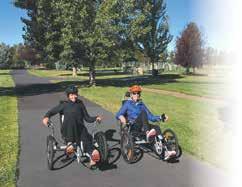
17 minute read
News
NEWS Seniors on the Pandemic, Race Relations and More
A conversation at COCC sparks an ongoing dialogue between residents at a local retirement home
Advertisement
By Marcus LeGrand
During a pandemic, nothing is “neutral” when it comes to being isolated. COVID-19 changed the way we interact as families. Older adults are urged to stay away from other people as much as possible, so visiting mom and dad is a difficult option. Yet after months of being at home, many want to go out into the world again.
Honest words were relayed to me during a virtual forum at Central Oregon Community College, “A Community Conversation About Race.” During the event, I had the pleasure of engaging with Touchmark Village at Mt. Bachelor Village residents, Florence Beier, 91, Rosalind Davenport, 74, Paul White, 79, and a fourth who decided not to be interviewed.
After the original forum, we met every Friday for a month in the fall to discuss their efforts in having open con-
versations about race. During the process, they led four different discussion groups. The materials used for the discussion were based on a racial history timeline of Oregon, current civic events, current noteworthy books and articles on discriminatory segregation, police profiling and systemic racism.
Beier, a journalist, teacher, communication consultant, and mediator, engaged early in activism. In 1946 near the University of California,-Los Angeles, she engaged in a “sit-in” at a lunch counter near campus which refused to serve Black students. This moment began her fight for social justice.
Davenport, was a 35-year educator experienced as a classroom instructor, including K-12 and graduate level instruction at UC-Berkeley Extension, and also served as an administrator. Davenport was also founding principal of a new school in Alameda, California, that absorbed Woodstock and two other small elementary schools. The school was named after Ruby Bridges, the Civil Rights activist. Davenport had the honor of consulting with and meeting Ms. Bridges during the initial months of the school’s operations.
White is a retired physicist who studied at the University of Texas at Austin, before teaching at St. Edward’s University, and then moving to Los Alamos National Laboratory in New Mexico. He worked on nuclear weapon design and in weapon program management, served as a technical advisor to arms control negotiations in Geneva, and the led the laboratory’s technical cooperation with Russian nuclear laboratories.
The pandemic has made it extremely hard for this population and unfortunately, the public has not investigated how to connect with our older citizens. Having the ability to interact in an antiracist learning environment with people of varying backgrounds and disciplines allowed us to re-examine how our older population has always helped to impact change.
Submitted
Marcus LeGrand.
Marcus LeGrand: I thought that we could start with a simple question to lay a foundation for our conversation, but this first one has many complex explanations. You have been isolated at Touchmark Village since March. What has been the most difficult part for you and other residents?
Rosalind Davenport: It has been hard for people here who do not have the technology or the overall means to connect. The isolation has been extremely emotional and finding ways to cope has been tough for me and other residents, especially for those who are single or have a deceased spouse. I grew up in an affectionate family, and not being able to hug my grandkids is hard, and the lack of touch and contact weighs on you.
Florence Beier: People our age and our families throughout history have
Submitted Submitted
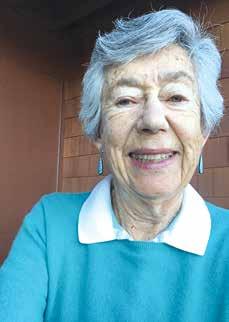
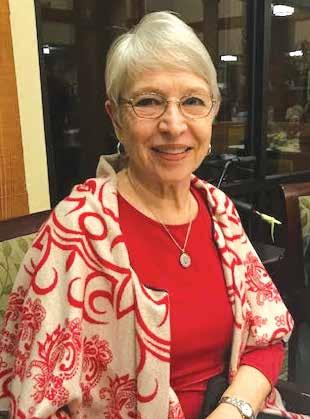
Rosalind Davenport.
experienced challenges such as World War II, the Civil Rights movement in the ‘60s, and the violence of recent years. It helps that we have a diversity of political points of view here. I keep in touch with my family by electronics and hikes.
Paul White: Having a partner to share the day with is a big boost. Similarly, others that have family close by or a day’s drive away have a distinct advantage over others who do not. And we see how this depresses many of our friends, and so do our best to help one another.
ML: Being that you cannot interact with the community in your normal fashion, what type of activities are you engaged in to discuss issues locally and nationally?
RD: The more positive aspect of living here is the people and being able to socialize. We developed book clubs and discussion groups, which allowed us to have conversations about Black Lives Matter and surviving during the pandemic. The Zoom classes offered us an opportunity to engage in discussions with other residents. At times we didn’t all agree, but the conversations were so necessary.
PW: The pandemic has changed the way we live, and it’s been difficult. Before we could easily go knock on someone’s door and visit with one another, plus, many of the residents still want to be a part of the outside community. It is a risk to go out, but we still want to walk trails or go grocery shopping. What we noticed is the younger population was not wearing masks, potentially placing our population in a difficult situation.
FB: This pandemic has been hard, but the perception is that the older population have lived their lives. What many do not understand is that we still have a lot of vitality and valuable insights to offer. We miss the community groups where we normally participate.
ML: Since you are not able to
engage in your normal manner, what advice would you give the community on how to engage with the older population? Plus, what do you think will happen once COVID is over?
FB: The perception is that many people feel we are old and not up to date on issues such as systemic racism. Plus, we can help find solutions if they would only ask. Once we can get back out into the community and invite others to Touchmark, we have a lot to contribute.
PW: A lot of us came to Touchmark because we wanted to continue our full lives. It was sometimes hard for us to do this living in single-family homes. We want to remain active and not just sit at home. We treasure the opportunities to walk, to be out in natural environment, and other ways to engage in the broader community. And now we see all these restrictions taking place in a political environment in which we want to engage, but in which it’s
extremely difficult to allow us to engage. So, when COVID restrictions are over, I think it is going to be a boost in the area of racial relations and social justice. I think older populations like us can draw on our experience to help to bring awareness to the changes we need to make.
RD: Future after COVID-19, it’s going to be a lot of work to get people reconnected, to get small businesses back on their feet, and it’s hard to know what the path looks like. See, we have never been in this situation before and fixing our community will take time. I believe there will be a different conversation about health care and next year will be an opportunity for change, different interactions with city leadership, and what we have learned from this experience is going to be a great lesson.
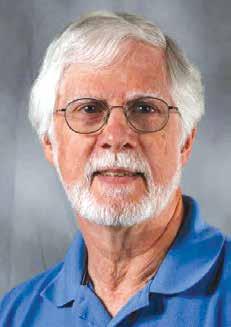
Paul White.
Noticias en Español El uso del bosque nacional aumentó 40% en nuestra región. Este año, el sistema de permisos planeado sigue adelante.
Por Damian Fagan Traducido por Jéssica Sánchez-Millar
Muchos están felices de ver el año 2020 en el retrovisor. Con una embravecida pandemia de coronavirus, una polémica elección, incendios forestales devastadores, un derrumbe económico y los mandatos de quedarse en casa, era obvio que cuando dieran luz verde, se presentaría el uso explosivo de las zonas de recreo. Las actividades de recreo y estar fuera, en la naturaleza, era casi el único juego en la ciudad, ¿cómo influyó “quintafecta” en los senderos en la zona centro de Oregon?
“Las cifras iniciales muestran que tuvimos cerca de un 40% de aumento en visitas al bosque nacional este año,” comentó Jean Nelson-Dean, funcionario de asuntos públicos del bosque nacional de Deschutes. “En 2018, hicimos una encuesta oficial sobre el uso de visitantes, lo cual mostró que tenemos 3.3 millones de visitantes al año en el bosque nacional de Deschutes. Si vemos el aumento de un 40% de los 3.3 millones de visitantes, fue un nivel fenomenal el uso de los lugares de recreo, lo cual definitivamente superó nuestra capacidad para atender a todos los visitantes y tuvo consecuencias en el medio ambiente natural.”
Una combinación del aumento de visitas, acompañadas de automóviles con un solo pasajero, fácilmente saturaron los lugares de estacionamiento a lo largo de los senderos de la zona centro de Oregon en el año 2020. Al principio, las zonas de acampar se usaron demasiado, pero sin el servicio de basura o el mantenimiento de los baños y especialmente cuando abrieron las reservaciones, rápidamente las llenaron los residentes locales y los visitantes que también buscaban un refugio y santuario
Aunque algunos voluntarios pudieron salir a mediados de julio, sus números fueron limitados por las precauciones de COVID-19. Junto con el cambio de parte del equipo de senderos a tareas de bomberos debido a las restricciones presupuestales, los senderos estaban faltos de mantenimiento a principios de la temporada por parte de los equipos de senderos voluntarios.
Entonces, ¿qué tanto afectó a los bosques locales la falta de voluntarios? “Tenemos el segundo programa de voluntarios más grande que cualquier otro bosque nacional en los Estados Unidos” dijo Nelson-Dean. “En promedio, anualmente tenemos más de 2,500 voluntarios que contribuyen con un valor de más de $1 millón de dólares en trabajo para mantener principalmente los bienes recreativos, pero también hacen otro tipo de trabajo. Si no fuera por el tremendo trabajo que hacen los voluntarios, no podríamos mantener nuestras más de 2,000 millas de senderos en el bosque nacional de Deschutes.”
El sistema de permisos para los espacios naturales en Central Cascades se extiende en línea
El año pasado, los bosques nacionales de Deschutes y Willamette suspendieron la implementación del sistema de permisos para los espacios naturales en Central Cascades, creado para proteger los recursos culturales y naturales, así como la experiencia de los visitantes al limitar la entrada a diferentes senderos en los espacios naturales de Three Sisters, Mt. Jefferson y Mt. Washington.
Usando la temporada pasada como barómetro, el servicio forestal decidió seguir adelante con la implementación de un sistema de permisos de entrada limitada durante este año, del 28 de mayo al 24 de septiembre. Los usuarios podrán obtener un permiso de uso durante el día o la noche a partir del 6 de abril por medio de Recreation. gov. Una parte de los permisos serán emitidos por adelantado durante toda la temporada, mientras que otros estarán disponibles siete días antes de la fecha de salida.

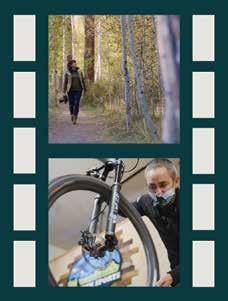
NEWS Oregon Democrats eye evictions, foreclosures, homelessness in 2021
Legislators unveiled proposals to build more shelters, protect people who live in tents, and create paths to homeownership
By Lauren Dake (OPB)
Before the COVID-19 pandemic upended our lives and before the wildfires devastated our state, Oregon was already in the midst of a housing crisis. Now, it’s worse.
For years, housing issues in the state legislature were considered more of an afterthought; issues to be tackled primarily at the local level. But in more recent history, the topic has taken center stage inside the state Capitol. In 2019, lawmakers passed ambitious proposals, such as a first-in-the-nation cap on rents and a move to end single-family zoning. But never before has the crisis in the state been so profound, making it one of the most pressing and urgent issues lawmakers will face this legislative session.
The 2020 wildfire season wiped out entire communities, destroying as many as 4,000 homes, many of them considered to be affordable housing. With the economic uncertainty and job losses spurred by the pandemic, lawmakers are also trying desperately to avoid an eviction cliff and ensure many more people don’t lose their homes in foreclosures.
Even before the pandemic and wildfires, Oregon’s rate of homeless was one of the highest in the United States. In 2019, an Urban Institute report found Oregon had rates of unsheltered homelessness of more than 3.5 times the national average. For years, there has been a chronic underproduction of housing. The Oregon Housing and Community Services agency estimated the state needs to see double the production of housing in order to meet the current demands and triple the current production of subsidized affordable housing units.
“For me, I think about it as, ‘What do we need to do specifically related to the pandemic and what do we need to do related to the pre-existing crises,” said Rep. Julie Fahey, D-Eugene, who oversees the Oregon House Committee on Housing.
This legislative session, lawmakers are considering bills to extend the moratorium on foreclosures, give renters more time to pay down their debt and expedite the process to create emergency housing shelters. Democrats have proposed increasing a tax credit for those who develop or rehabilitate housing for agricultural workers. They hope to help kids aging out of foster care with rental assistance. And they want to see the homeless crisis addressed through a racial-equity lens.
“This is the most unequal recession we have ever faced,” Sen. Kayse Jama, the chair of the Senate Committee on Housing and Development, said in a statement. “We must stay focused on helping tenants who have lost their income through no fault of their own and help keep people housed.”
Democratic lawmakers have proposed spending $535 million to go toward the housing crisis this session. About $230 million would be carved out for affordable rental housing construction and another $30 million would help qualifying individuals put a down payment on home purchases. Some of that money, nearly $50 million, would go toward creating more navigation centers statewide, which are low-barrier emergency shelters open seven days a week and aim to connect those living without shelter to services that could help them. Lawmakers are also expecting more assistance from the federal government, which could be put toward offering renters more relief.
On Monday, Democrats — who hold the majority in both chambers of the Oregon Legislature — unveiled some of the policy proposals they consider to be priorities during the 2021 legislative session. Here is a quick look at some of those bills:
Emergency Shelter Expedited Siting,
House Bill 2006: The lack of an adequate number of shelter beds has plagued the state for several years. This bill aims to help local governments cut through some of the red tape to quickly create an emergency shelter. The bill would allow local governments to waive design, planning and zoning regulations to approve the siting of emergency shelters. Shelters would still need to comply with certain building codes and meet certain public health and safety requirements. The emergency siting authority would expire July 1, 2022, although shelters could remain open after that date.
Shelter Support and Navigation
Centers, House Bill 2004: This is a companion bill to go with House Bill 2006. It would carve out $45 million to help build shelter capacity statewide and create navigation centers in Bend, Eugene, McMinnville, Medford and Salem. The bulk of the money, $26.5 million, would go toward grants to help increase low-barrier shelter capacity, to put toward creating necessary elements of a facility such as bathrooms. Some of the money, about $2 million, would go to Oregon Housing and Community Services so they can offer technical assistance.
Mobile Crisis Intervention Teams,
House Bill 2417: More than three decades ago, the city of Eugene created a public safety program where mental health professionals - instead of police officers - responded to some public safety crises that involved homelessness, addiction or mental illnesses. A crisis worker who has training in the mental health field arrives with either a nurse, paramedic or EMT. This bill has been dubbed the “CAHOOTS” (Crisis Assistance Helping Out On The Streets) bill, named after the program in Lane
Kristyna Wentz-Graff / OPB
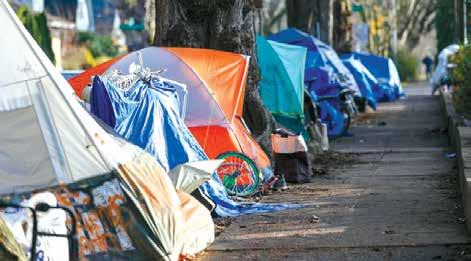
Tents line a sidewalk in Northeast Portland. Legislation proposed by Oregon Democrats would make it easier to approve homeless shelters, and harder to sweep away tent dwellings.
County. The bill would put the Department of Human Services (DHS) in charge of providing 50% matching grants to cities or counties to create and run their own mobile crisis intervention programs. It carves out $10 million from the general fund.
Protecting Survival Activities in
Public Space, House Bill 3115: This bill would prevent cities and counties from enacting sweeping laws prohibiting homeless people from camping on public land. The goal of this bill, House Speaker Tina Kotek said, is to ensure there are “objectively reasonable” policies in place when it comes to determining where and how people can live outdoors. If a city or local government were to enact a more restrictive measure, this could allow homeless people to sue in order to stop them.
COVID Recovery Protection, Senate
Bill 282: The current eviction moratorium expires on July 1. On that date, tenants will owe all of their back rent, along with the current month’s rent. This bill would extend the grace period by which tenants must pay back their rent until February 2022. Proponents have made the case that millions of dollars in federal assistance will still be coming into the state, but not yet distributed during this time period. So, extending the grace period could mean landlords are still compensated financially while giving tenants more time to pay their debt.
Individual Assessments in Rent
Applications, Senate Bill 291: This bill aims to make it more difficult to screen out tenants due to an applicant’s arrest and conviction history, with the larger goal of trying to reduce existing racial disparities in Oregon housing. The bill would prohibit landlords from considering arrests that don’t end in a conviction, or that result in a diversion. A tenant could not be rejected if they had been convicted for something that is no longer a crime in Oregon. The bill would also require a landlord to consider the severity of the incident, how much time has elapsed and the age of the applicant at the time of the incident. If the landlord denies the application, they must provide a written statement saying why within 14 days.
Foreclosure Moratorium Exten-
sion, House Bill 2009: This bill would extend the moratorium on foreclosures until Sept. 1. The bill would be retroactive back to Dec. 31 and would only apply to residential property owners.
Manufactured Home Park Tenants’ Opportunity to Purchase, House Bill
2364: This bill would require owners of a residential facility who is considering selling their property to give tenants 20 days to form a tenant committee and give them the right of first refusal to purchase the property. If the owner receives notice within the correct time frame that the tenant committee wants to purchase the facility, the owner may not make or accept a purchase offer for the facility. The owner must first make an offer in writing to sell the facility to the tenants committee at an equal or lower price and on similar terms.
Racial Disparities in Home Owner-
ship, Senate Bill 79: This measure carves out money to help offer grants and loans for down payment assistance. The goal is to help increase homeownership access to low-income individuals and to begin to address racial disparities in home ownership. The bill allows Oregon’s nine federally-recognized tribes to use the homeownership assistance program in their communities. It would also allow for culturally specific counseling, financial literacy classes and work to ensure language barriers are less of a barrier when it comes to buying a home.
Healthy Homes Program, House
Bill 2842: This measure would create a “healthy homes” program within the state’s health authority. The program’s goal would be to provide grants for low-income households and landlords to repair and rehabilitate residential dwelling units that could be considered health hazards. -This story was republished through a content sharing agreement with Oregon Public Broadcasting.





